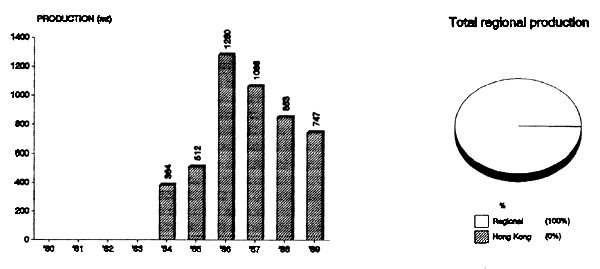
EPINEPHELUS spp.
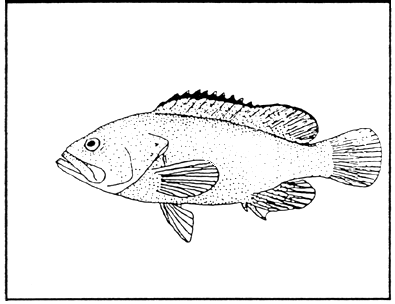
HISTORY
Marine finfish culture, on the other hand, only came into existence in the late sixties, when aged and retiring fishermen first started the practice by keeping captured young fish in underwater cages. As live marine fish were selling at high price and were in high demanded, more fishermen and entrepreneurs began to invest in larger scale operations. In the 1970s, marine fish cage culture developed in a largely unrestrained manner and mariculture proliferated in 54 areas, covering almost every sheltered bay of the territory, creating aesthetic problems as well as conflicting usage of some water bodies. In view of this, the government enacted the Marine Fish Culture Ordinance in 1980 requiring all mariculture operations to be practiced under licenses within designated fish culture zones. Currently there are some 1750 licensed operators with a total raft area of 49.5 ha in 27 fish culture zones, occupying a total area of 179 hectares. The culture system involves growing prime species of grouper from fry or fingerlings to the marketable size in netcages suspended by means of floating wooden rafts in the sea. Currently, four grouper species are cultured: Epinephelus akaara, Epinephelus awoara, Epinephelus tauvina and Epinephelus chlorostigma. Previously, considerable quantity of E. akaara fry were collected from local coastal waters. Nowadays, fingerlings of E. akaara are imported from China, while fingerlings of other species are mainly imported from the Philippines and Thailand. The majority of the mariculture farms are small-capital operations and are operated by family members. In 1989, approximately 830 tonnes of grouper were produced.

CULTURE PRACTICES
Marine fish farming in Hong Kong is practiced using the floating netcage method. The simple wooden frames with plastic containers as floats, used to suspend the netcages, cannot withstand very strong waves or currents. In Hong Kong, the frequent stormy condition associated with the occasional typhoon in the summer and the northeast monsoon throughout the winter, have restricted marine finfish culture to sheltered areas. In addition, with the busy water traffic, most of the fish culture zones are located in inshore sheltered bays with fairly limited water depth. The netcages made of synthetic fibre netting are suspended below wooden rafts which are anchored to the seabed with a number of mooring devices such as iron anchors or concrete blocks. Plastic containers, styrofoam floats and fiber-glass floats are used as buoys to keep the rafts afloat. An average farm occupies a raft area of 250 m2. About 70–80% of the raft area is equipped with cages of 3 × 3 × 2–3 m (depth) in dimensions. All the farms are intensively managed with high stocking density. The yield per ha of raft area in 1989 amounted to 61 tonnes. Mixed culture of groupers, seabreams and snappers within one netcage is quite common to encourage better foraging efficiency and ensure better utilization of the cage space. The groupers are fed with trash fish (sardines, anchovies, small mackerel, rabbit fish or pony fish caught by purse seiners or trawlers) daily and reach the marketable size of 600 g (1 kg for Epinephelus tauvina) in about 18–24 months. Normal food conversion ratio is low ranging from 12:1 to 15:1. Grouper is a high-priced seafood and has been the most important cultured species. Most of the production is consumed locally. The Agriculture and Fisheries Department (AFD) is presently concentrating on research and management work on the following three areas of marine finfish culture: (i) minimising impacts on the environment, (ii) minimising self-pollution effects, and (iii) fish disease problems. Research and development work at AFD are therefore directed towards improvement of husbandry and management techniques and development of new farming systems.
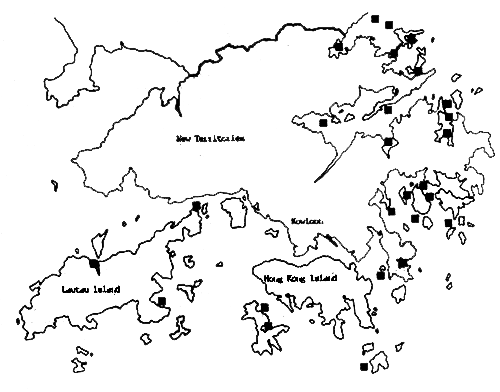
| STATUS | SPECIES |
|---|---|
| E. akaara, E. awoara, E. tauvina and E. chlorostigma | |
| Source of seed | Wild (imported) |
| Culture method | Floating netcage |
| Yield/ha | 61 mt/ha (raft area) |
| Marketing | Domestic |
| Production area | 49.5 ha (total fish culture raft area) |
| Level of culture | Developing |
| Major constraints | Limited fry supply; Limited culture sites |

LATES CALCARIFER
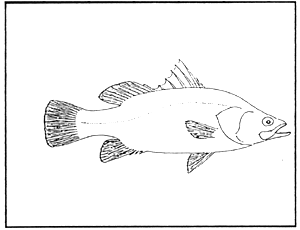
HISTORY
Marine finfish culture, on the other hand, only came into existence in the late sixties, when aged and retiring fishermen first started the practice by keeping captured young fish in underwater cages. As live marine fish were selling at high price and were in high demanded, more fishermen and entrepreneurs began to invest in larger scale operations. In the 1970s, marine fish cage culture developed in a largely unrestrained manner and mariculture proliferated in 54 areas, covering almost every sheltered bay of the territory, creating aesthetic problems as well as conflicting usages of some water bodies. In view of this, the government enacted the Marine Fish Culture Ordinance in 1980 requiring all mariculture operations to be practiced under licenses within designated fish culture zones. Currently there are some 1750 licensed operators with a total raft area of 49.5 ha in 27 fish culture zones, occupying a total area of 179 hectares. The culture system involves growing seabass from fry or fingerlings to the marketable size in netcages suspended by means of floating wooden rafts in the sea. Lates calcarifer has long been a by-product of brackishwater tidal shrimp pond known as ‘gei-wai’ or ‘tambak’ in Hong Kong. It became one of the major species in marine netcage culture only in 1981. The fry are imported from Thailand and Taiwan. In late 1986, a serious disease outbreak occurred which wiped out most of the fingerlings, leading to the low yield in 1987. The reservation of fish farmers to stock L. calcarifer in 1988 has led to a low production of only 20 tonnes in that year. In 1989 the situation has improved with a production of 170 tonnes.

CULTURE PRACTICES
Marine fish farming in Hong Kong is practiced using the floating netcage method. The simple wooden frames with plastic containers as floats, used to suspend the netcages, cannot withstand very strong waves or currents. In Hong Kong, the frequent stormy condition associated with the occasional typhoon in the summer and the northeast monsoon throughout the winter, have restricted marine finfish culture to sheltered areas. In addition, with the busy water traffic, most of the fish culture zones are located in inshore sheltered bays with fairly limited water depth. Netcages made of synthetic fibre netting are suspended below wooden rafts which are anchored to the seabed with a number of mooring devices such as iron anchors or concrete blocks. Plastic containers, styrofoam floats and fiber-glass floats are used as buoys to keep the rafts afloat. The size of the netcage is variable but a size of 3m × 3m × 3m is the most common. As average farm occupies a raft area of 250 m2. Seabass are fed once or twice daily with minced fresh fish which normally comprises sardines, anchovies, small mackerel, rabbit fish or pony fish caught by purse seiners or trawlers. Normal food conversion ratio is low ranging from 12:1 to 15:1. Most of the fish reach the marketable size at about 300–350 g in 10 months. Most of the production is consumed locally. The Agriculture and Fisheries Department (AFD) is presently concentrating on research and management work on the following three areas of marine finfish culture: (i) minimising impacts on the environment, (ii) minimising self-pollution effects, and (iii) fish disease problems. Studies to find suitable formulation for the major cultured species and feed supplements to be used with trash fish are underway to solve the malnutrition problem. Research and development work at AFD are therefore directed towards improvement of husbandry and management techniques and development of new farming systems. Strict enforcement of the Marine Fish Culture Ordinance will hopefully prevent bad practices and help improve the environmental condition within fish culture zones.
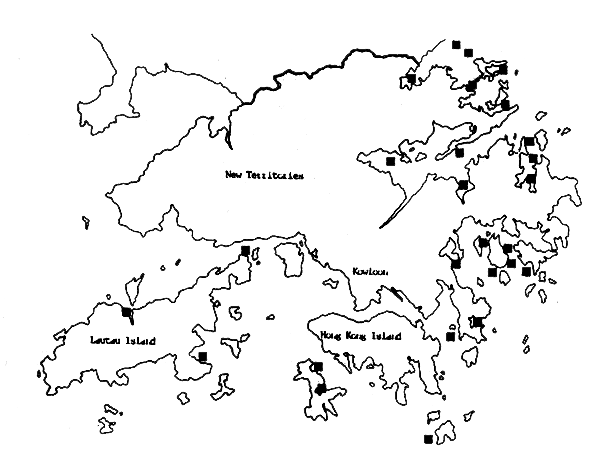
| STATUS | SPECIES |
|---|---|
| Lates calcarifer | |
| Source of seed | Wild |
| Culture method | Floating netcage |
| Yield/ha | 61 mt/ha (raft area) |
| Marketing | Domestic |
| Production area | 49.5 ha (total fish culture raft area) |
| Level of culture | Developing |
| Major constraints | Limited fry supply; Limited culture sites |
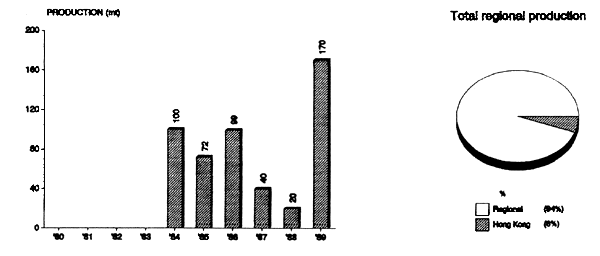
CHRYSOPHRYS MAJOR, RHABDOSARGUS SARBA and MYLIO spp.
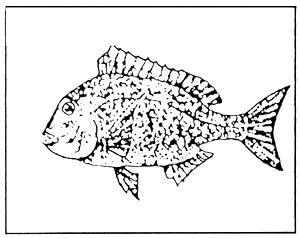
HISTORY
Marine finfish culture, on the other hand, only came into existence in the late sixties, when aged and retiring fishermen first started the practice by keeping captured young fish in underwater cages. As live marine fish were selling at high price and were in high demanded, more fishermen and entrepreneurs began to invest in larger scale operations. In the 1970s, marine fish cage culture developed in a largely unrestrained manner and mariculture proliferated in 54 areas, covering almost every sheltered bay of the territory, creating aesthetic problems as well as conflicting usages of some water bodies. In view of this, the government enacted the Marine Fish Culture Ordinance in 1980 requiring all mariculture operations to be practiced under licenses within designated fish culture zones. Currently there are some 1750 licensed operators with a total raft area of 49.5 ha in 27 fish culture zones, occupying a total area of 179 hectares. The culture system involves growing seabream from fry to the marketable size in netcages suspended by means of floating wooden rafts in the sea. In total five species of seabreams are cultured in Hong Kong: Chrysophrys major, Rhabdosargus sarba, Mylio berda, Mylio latus and Mylio macrocephalus. The earliest record of seabream culture is that of red pargo, C. major, conducted in the experimental farm of the Agriculture and Fisheries Department in 1969. All seabream fry are obtained from local coastal waters and therefore the yield of various seabream species fluctuates depending on the relative proportion of fry caught. The majority of the mariculture farms are small-capital operations operated by family members. The production of seabream in 1989 was 1,330 tonnes.
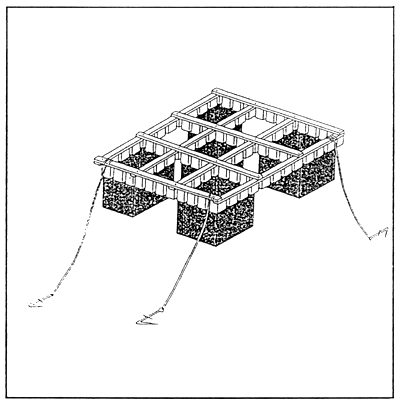
CULTURE PRACTICES
Marine fish farming in Hong Kong is practiced using the floating netcage method. The simple wooden frames with plastic containers as floats, used to suspend the netcages, cannot withstand very strong waves or currents. In Hong Kong, the frequent stormy condition associated with the occasional typhoon in the summer and the northeast monsoon throughout the winter, have restricted marine finfish culture to sheltered areas. In addition, with the busy water traffic, most of the fish culture zones are located in inshore sheltered bays with fairly limited water depth. Netcages made of synthetic fibre netting are suspended below wooden rafts which are anchored to the seabed with a number of mooring devices such as iron anchors or concrete blocks. Plastic containers, styrofoam and fiber-glass floats are used as buoys to keep the rafts afloat. The size of the cage is variable but a size of 3×3×3 m is the most common. An average farm occupies a raft area of 250 m2.
Seabream are usually kept with groupers in the same cage and are fed once or twice daily with minced fresh fish which normally comprises sardines, anchovies, small mackerel, rabbit or pony fish caught by purse seiners or trawlers. Normal food conversion ratio is low ranging from 12:1 to 15:1. The marketable size of about 380 g is reached in 18 months. Mylio macrocephalus, however, is a slow growing species that reaches the same marketable size in 3 years. Most seabream are consumed locally but recently most of the C. major, both fry or adults, are exported to Japan where the demand and price are much higher. The Agriculture and Fisheries Department (AFD) is presently concentrating on research and management work on the following three areas of marine finfish culture: (i) minimising impacts on the environment, (ii) minimising self-pollution effects, and (iii) fish disease problems. Studies to find suitable formulation for the major cultured species and feed supplements to be used with trash fish are underway to solve the malnutrition problem. Research and development work at AFD are therefore directed towards improvement of husbandry and management techniques and development of new farming systems.
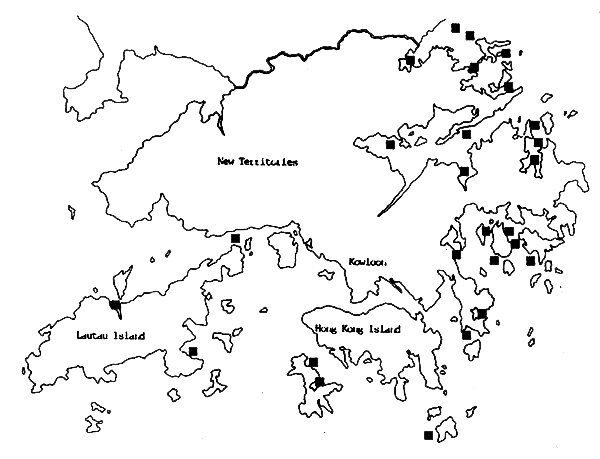
| STATUS | SPECIES |
|---|---|
| C. major, R. sarba and Mylio spp. | |
| Source of seed | Wild |
| Culture method | Floating netcage |
| Yield/ha | 61 mt/ha (raft area) |
| Marketing | Domestic |
| Production area | 49.5 ha (total fish culture raft aroa) |
| Level of culture | Developing |
| Major constraints | Limited fry supply; Diseases; Limited culture sites |
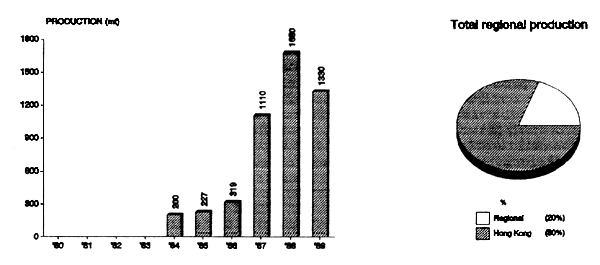
LUTJANUS RUSSELLI and LUTJANUS ARGENTIMACULATUS
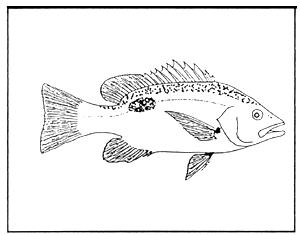
HISTORY
Marine finfish culture, on the other hand, only came into existence in the late sixties, when aged and retiring fishermen first started the practice by keeping captured young fish in underwater cages. As live marine fish were selling at high price and were in high demanded, more fishermen and entrepreneurs began to invest in larger scale operations. In the 1970s, marine fish cage culture developed in a largely unrestrained manner and mariculture proliferated in 54 areas, covering almost every sheltered bay of the territory, creating aesthetic problems as well as conflicting usage of some water bodies. In view of this, the government enacted the Marine Fish Culture Ordinance in 1980 requiring all mariculture operations to be practiced under licenses within designated fish culture zones. Currently there are some 1750 licensed operators with a total raft area of 49.5 ha in 27 fish culture zones, occupying a total area of 179 hectares. The culture system involves growing snapper from fry or fingerlings to the marketable size in netcages suspended by means of floating wooden rafts in the sea. The first commercial trial of culturing snapper was conducted in 1969. Nowadays, 2 species of snapper are cultured: Lutjanus russelli and Lutjanus argentimaculatus. The fry of both species are imported from Thailand and the Philippines and are therefore less tolerant to low temperature. During winter months in Hong Kong, depending on the winter temperature, they occasionally suffer from serious disease outbreaks. The majority of the mariculture farms are small-capital operations and are operated by family members. The production in 1985 was 258 tonnes while in 1989 it was 590 tonnes.
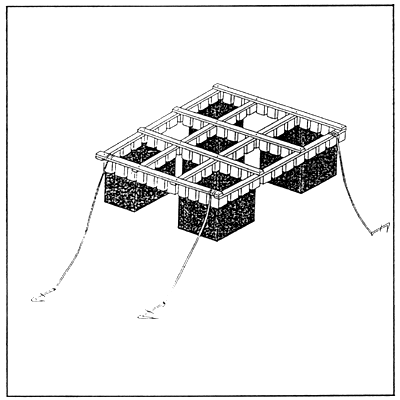
CULTURE PRACTICES
Marine fish farming in Hong Kong is practiced using the floating netcage method. The simple wooden frames with plastic containers as floats, used to suspend the netcages, cannot withstand very strong waves or currents. In Hong Kong, the frequent stormy condition associated with the occasional typhoon in the summer and the northeast monsoon throughout the winter, have restricted marine finfish culture to sheltered areas. In addition, with the busy water traffic, most of the fish culture zones are located in inshore sheltered bays with fairly limited water depth. Netcages made of synthetic fibre netting are suspended below wooden rafts which are anchored to the seabed with a number of mooring devices such as iron anchors or concrete blocks. Plastic containers, styrofoam and fiber-glass floats are used as buoys to keep the rafts afloat. The size of the netcage is variable but a size of 3×3×3 m is the most common. An average farm occupies a raft area of 250 m2.
Snappers are usually kept with groupers in the same netcage and are fed once or twice daily with minced fresh fish which normally comprises sardines, anchovies, small mackerel, rabbit fish or pony fish caught by purse seiners or trawlers. Normal food conversion ratio is low ranging from 12:1 to 15:1. The marketable size for L. argentimaculatus is 1.2 kg. The grow-out period is around 24 months. Most of the production is consumed locally. The Agriculture and Fisheries Department (AFD) is presently concentrating on research and management work on the following three areas of marine finfish culture: (i) minimising impacts on the environment, (ii) minimising self-pollution effects, and (iii) fish disease problems. Studies to find suitable formulation for the major cultured species and feed supplements to be used with trash fish are underway to solve the malnutrition problem. Research and development work at AFD are therefore directed towards improvement of husbandry and management techniques and development of new farming systems. Strict enforcement of the Marine Fish Culture Ordinance will hopefully prevent bad practices and help improve the environmental condition within fish culture zones.
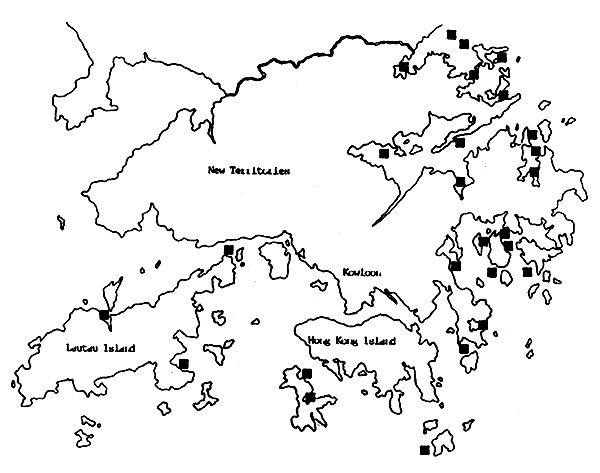
| STATUS | SPECIES |
|---|---|
| L. russelli and L. argentimaculatus | |
| Source of seed | Wild |
| Culture method | Floating netcage |
| Yield/ha | 61 mt/ha (raft area) |
| Marketing | Domestic |
| Production area | 49.5 ha (total fish culture raft area) |
| Level of culture | Developing |
| Major constraints | Limited fry supply; Diseases; Limited culture sites |
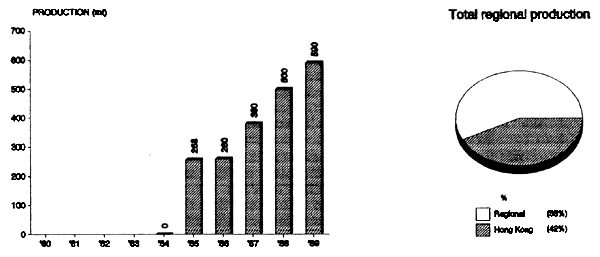
CRASSOSTREA GIGAS

HISTORY
Oyster culture has been practiced in Hong Kong for at least 200 years. The Pacific oyster (Crassostrea gigas) has always been cultured on the intertidal mudflats in the North-West corner of Hong Kong by the traditional bottom culture method. Historically the industry produced fresh oyster meat mainly for processing to dried oyster or oyster sauce for export. This was changed in the 1960s with the increased demand for fresh meat. Influx of oyster sauce and dried oyster from China for re-export to the States also contributed to this change in the industry. In recent decades, oyster production from spat has decreased gradually owing to difficulties in collecting sufficient spat and the long growth period (4–5 years) to attain marketable size. This has been attributed to the increasing pollution of the water body and the deterioration of the oyster bed condition arising from land-based activities in the vicinity. To supplement local oyster production, the practice of fattening young oysters purchased from China has become increasingly common, and at present it dominates the industry. Total oyster culture area is around 640 ha. In 1989, the production of oyster meat was 140 tonnes valued at about HK$ 5 million. Almost all the oysters are marketed live or fresh and consumed in Hong Kong. Only negligible amounts are used for producing dried oysters and oyster sauce. The major oyster marketing village is Lau Fau Shan where the oysters are shucked before they are transported elsewhere. The shucked oysters are kept alive and fresh in containers filled with filtered seawater. Some of the oysters are retailed to consumers directly, however most are sold either to restaurants or to seafood wholesalers.
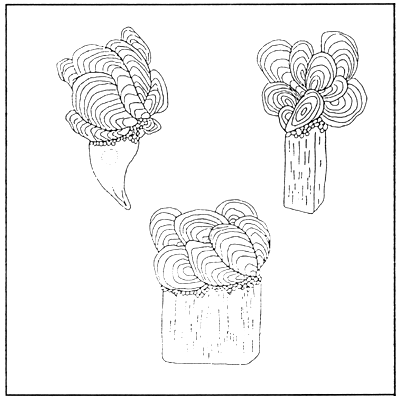
CULTURE PRACTICES
The Pacific oyster, Crassostrea gigas, is cultured in Hong Kong by the traditional bottom culture method. Oyster culture is concentrated around Deep Bay which is situated in the North-West corner of Hong Kong. It is run on a family basis by about 200 farm households or some 800 people. Spats are collected from the wild by placing rocks, old shells, cement tiles or posts on the shallow parts of the oyster beds between May and June each year. Later from October to November, the cultches with the collected spats are then transferred to deeper waters for growth for 4–5 years to attain the marketable size of 110–120 mm shelllength. Recently, with the general reduction in spat settlement and slow growth rate, some oyster farmers turned to fattening young oysters that are purchased from China. These young oysters are placed in the oyster beds for about 8–12 months before marketing. For both spat growth and fattening, no feed or fertilizer are used or required, as the oysters rely on natural supply of phytoplankton in the surrounding seawater. The traditional bottom culture method has restricted oyster culture activity to the mud flats in Deep Bay, the conditions of which have deteriorated over the years with land development around it. In the mid-seventies, culture trials conducted by Agriculture and Fisheries Department showed that raft culture method reduces the effects of pollution and provides better utilization of the water column with higher yields. The raft culture method was introduced to the oyster farmers in the early eighties. This technique, however, was only adopted by a few farmers owing to the additional capital requirement involved in raft construction and transportation to the marketing centre. Currently, with the various land developments around Deep Bay and the port and Airport Development Scheme around north Lantau Island affecting and taking up most of the western waters suitable for oyster culture, further development of this industry is very limited. At present the government is considering the possibility of setting up depuration facilities to counteract the increase in sewage pollution and associated contamination by faecal bacteria.

| STATUS | SPECIES |
|---|---|
| Crassostrea gigas | |
| Source of seed | Wild |
| Culture method | Bottom |
| Yield/ha | NA |
| Marketing | Domestic |
| Production area | 640 ha |
| Level of culture | Developed |
| Major constraints | Limited spat supply & site; Poor water quality & beds; |
